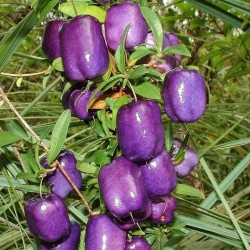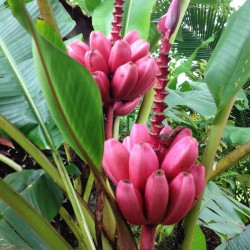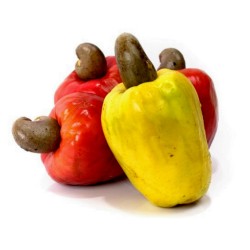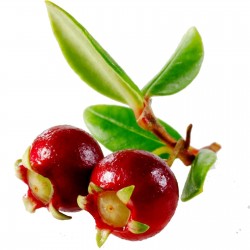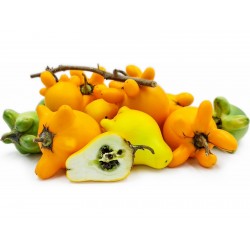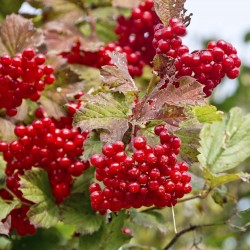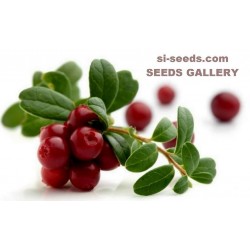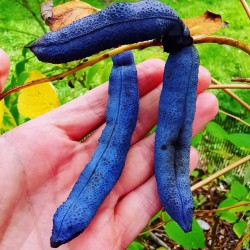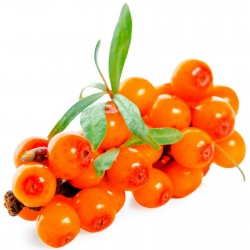Seeds Gallery EU,
5/
5
<!DOCTYPE html>
<html>
<head>
<meta http-equiv="Content-Type" content="text/html; charset=UTF-8" />
</head>
<body>
<h2><strong><strong>Cashew Nut Seeds Cashew Apple (Anacardium occidentale)</strong><br /></strong></h2>
<h2><span style="color: #ff0000;"><strong>Price for Package of 1 seeds.</strong></span></h2>
<div>
<p>The<span> </span><b>cashew tree</b><span> </span>(<i>Anacardium occidentale</i>) is a tropical evergreen tree that produces the cashew<span> </span>seed<span> </span>and the cashew<span> </span>apple.<span> </span>It can grow as high as 14 m (46 ft), but the dwarf cashew, growing up to 6 m (20 ft), has proved more profitable, with earlier maturity and higher yields.</p>
<p>The species is native to<span> </span>Central America, the<span> </span>Caribbean Islands, and<span> </span>northern South America.<span> </span>Portuguese colonists in Brazil began exporting cashew nuts as early as the 1550s.<span> </span>In 2017,<span> </span>Vietnam,<span> </span>India, and<span> </span>Ivory Coast<span> </span>were the major producers.</p>
<p>The cashew seed, often simply called a cashew, is widely consumed. It is eaten on its own, used in recipes, or processed into cashew cheese or<span> </span>cashew butter. The shell of the cashew seed yields derivatives that can be used in many applications including lubricants, waterproofing, paints, and arms production, starting in World War II.<span> </span>The cashew apple is a light reddish to yellow fruit, whose pulp can be processed into a sweet,<span> </span>astringent<span> </span>fruit drink or distilled into liquor.</p>
<h2><span class="mw-headline" id="Etymology">Etymology</span></h2>
<p>Its English name derives from the Portuguese name for the fruit of the cashew tree<span> </span><i>caju</i><span> </span>(Portuguese pronunciation: [kaˈʒu]), which itself is derived from the<span> </span>Tupian<span> </span>word<span> </span><i>acajú</i>, literally meaning "nut that produces itself".<sup id="cite_ref-morton_1-2" class="reference">[1]</sup>The generic name "Anacardium" (derived from Greek ἀνά (aná), meaning "outside," and καρδία (kardía), meaning "heart", refers to the unusual location of the seed (the heart) outside of the fruit.</p>
<h2><span class="mw-headline" id="Habitat_and_growth">Habitat and growth</span></h2>
<div class="thumb tright">
<div class="thumbinner"><img alt="" src="https://upload.wikimedia.org/wikipedia/commons/thumb/d/d5/Cashew_Flower.JPG/200px-Cashew_Flower.JPG" width="200" height="150" class="thumbimage" />
<div class="thumbcaption">
<div class="magnify"></div>
Flower of cashew tree</div>
</div>
</div>
<div class="thumb tright">
<div class="thumbinner"><img alt="" src="https://upload.wikimedia.org/wikipedia/commons/thumb/3/34/Cajueiro_Meconta.jpg/200px-Cajueiro_Meconta.jpg" width="200" height="133" class="thumbimage" />
<div class="thumbcaption">
<div class="magnify"></div>
Cashew tree</div>
</div>
</div>
<p>The cashew tree is large and<span> </span>evergreen, growing to 14 m (46 ft) tall, with a short, often irregularly shaped trunk. The<span> </span>leaves<span> </span>are spirally arranged, leathery textured, elliptic to obovate, 4–22 cm (1.6–8.7 in) long and 2–15 cm (0.79–5.91 in) broad, with smooth margins. The<span> </span>flowers<span> </span>are produced in a<span> </span>panicle<span> </span>or<span> </span>corymb<span> </span>up to 26 cm (10 in) long; each flower is small, pale green at first, then turning reddish, with five slender, acute<span> </span>petals<span> </span>7–15 mm (0.28–0.59 in) long.<span> </span>The largest cashew tree in the world<span> </span>covers an area around 7,500 m<sup>2</sup>(81,000 sq ft); it is located in<span> </span>Natal, Rio Grande do Norte, Brazil.</p>
<p>The fruit of the cashew tree is an<span> </span>accessory fruit<span> </span>(sometimes called a pseudocarp or false fruit).<sup id="cite_ref-morton_1-3" class="reference">[1]</sup><span> </span>What appears to be the fruit is an oval or<span> </span>pear-shaped<span> </span>structure, a<span> </span>hypocarpium, that develops from the<span> </span>pedicel<span> </span>and the receptacle of the cashew flower.<sup id="cite_ref-5" class="reference">[5]</sup><span> </span>Called the cashew apple, better known in Central America as<span> </span><i>marañón</i>, it ripens into a yellow or red structure about 5–11 cm (2.0–4.3 in) long. It is edible and has a strong "sweet" smell and taste.<sup class="noprint Inline-Template Template-Fact">[<i><span title="This claim needs references to reliable sources. (March 2018)">citation needed</span></i>]</sup></p>
<p>The true fruit of the cashew tree is a kidney or boxing-glove shaped<span> </span>drupe<span> </span>that grows at the end of the cashew apple. The drupe develops first on the tree, and then the pedicel expands to become the cashew apple.<sup id="cite_ref-morton_1-4" class="reference">[1]</sup><span> </span>Within the true fruit is a single<span> </span>seed, which is often considered a<span> </span>nut, in the culinary sense. The seed is surrounded by a double shell containing an allergenic<span> </span>phenolic<span> </span>resin,<span> </span>anacardic acid, a potent skin<span> </span>irritant<span> </span>chemically related to the better-known allergenic oil<span> </span>urushiol<span> </span>which is also a<span> </span>toxin<span> </span>found in the related<span> </span>poison ivy. Some people are<span> </span>allergic<span> </span>to cashews, but cashews are a less frequent<span> </span>allergen<span> </span>than tree nuts or<span> </span>peanuts.<sup id="cite_ref-Rosen_6-0" class="reference">[6]</sup></p>
<p>While the cashew plant is native to northeast<span> </span>Brazil, the<span> </span>Portuguese<span> </span>took it to<span> </span>Goa, India, between 1560 and 1565. From there, it spread throughout Southeast Asia and eventually Africa.</p>
<h2><span class="mw-headline" id="Cashew_nut_and_shell">Cashew nut and shell</span></h2>
<div class="thumb tright">
<div class="thumbinner"><img alt="" src="https://upload.wikimedia.org/wikipedia/commons/thumb/1/16/Shelling_cashews.jpg/220px-Shelling_cashews.jpg" width="220" height="165" class="thumbimage" />
<div class="thumbcaption">
<div class="magnify"></div>
A woman uses a machine to shell cashews in Phuket, Thailand.</div>
</div>
</div>
<div class="thumb tright">
<div class="thumbinner"><img alt="" src="https://upload.wikimedia.org/wikipedia/commons/thumb/3/3c/CashewSnack.jpg/220px-CashewSnack.jpg" width="220" height="165" class="thumbimage" />
<div class="thumbcaption">
<div class="magnify"></div>
Cashews as a snack</div>
</div>
</div>
<p>Culinary uses for cashew seeds in<span> </span>snacking<span> </span>and cooking are similar to those for all tree seeds called nuts.</p>
<p>Cashews are commonly used in<span> </span>Indian cuisine<span> </span>and<span> </span>Pakistani cuisine, whole for garnishing sweets or curries, or ground into a paste that forms a base of sauces for curries (e.g.,<span> </span><i>korma</i>), or some sweets (e.g.,<span> </span><i>kaju barfi</i>). It is also used in powdered form in the preparation of several Indian sweets and desserts. In<span> </span>Goan cuisine, both roasted and raw kernels are used whole for making curries and sweets. Cashews are also used in<span> </span>Thai<span> </span>and<span> </span>Chinese cuisines, generally in whole form. In the Philippines, cashew is a known product of<span> </span>Antipolo, and is eaten with<span> </span><i>suman</i>. The province of<span> </span>Pampanga<span> </span>also has a sweet dessert called<span> </span><i>turrones de casuy</i>, which is cashew<span> </span>marzipan<span> </span>wrapped in white wafers. In<span> </span>Indonesia, roasted and salted cashews are called<span> </span><i>kacang mete</i><span> </span>or<span> </span><i>kacang mede</i>, while the cashew apple is called<span> </span><i>jambu monyet</i><span> </span>(translates in English to monkey rose apple).</p>
<p>In the 21st century, cashew cultivation increased in several African countries to meet the demands for manufacturing<span> </span>cashew milk, a<span> </span>plant milk<span> </span>alternative to<span> </span>dairy milk.<sup id="cite_ref-7" class="reference">[7]</sup><span> </span>In<span> </span>Mozambique,<span> </span><i>bolo polana</i><span> </span>is a cake prepared using powdered cashews and mashed potatoes as the main ingredients. This dessert is popular in South Africa.<sup id="cite_ref-8" class="reference">[8]</sup></p>
<p>In<span> </span>Brazil, cashew fruit juice and the fruit pulp are used in the production of sweets, juice, alcoholic beverages, such as<span> </span><i>cachaça</i>, and as a flour, milk or cheese.<sup id="cite_ref-9" class="reference">[9]</sup><span> </span>In<span> </span>Panama, the cashew fruit is cooked with water and sugar for a prolonged time to make a sweet, brown, paste-like dessert called<span> </span><i>dulce de marañón</i>, with<span> </span><i>marañón</i><span> </span>as a Spanish name for cashew.<sup class="noprint Inline-Template Template-Fact">[<i><span title="This claim needs references to reliable sources. (November 2018)">citation needed</span></i>]</sup></p>
<p>The<span> </span>shell<span> </span>of the cashew nut contains oil compounds which may cause<span> </span>contact dermatitis<span> </span>similar in severity to that of poison ivy, primarily resulting from the<span> </span>phenolic lipids,<span> </span>anacardic acid, and<span> </span>cardanol.<sup id="cite_ref-10" class="reference">[10]</sup><span> </span>Due to the possible dermatitis, cashews are typically not sold in the shell to consumers.<sup id="cite_ref-11" class="reference">[11]</sup><span> </span>Readily and inexpensively extracted from the waste shells, cardanol is under research for its potential applications in<span> </span>nanomaterials<span> </span>and<span> </span>biotechnology.<sup id="cite_ref-hamad_12-0" class="reference">[12]</sup></p>
<h2><span class="mw-headline" id="Production">Production</span></h2>
<table class="wikitable">
<tbody>
<tr>
<th colspan="2">Cashew production (kernels), 2017</th>
</tr>
<tr>
<td><center>Country</center></td>
<td><center>Production<br /><small>(tonnes)</small></center></td>
</tr>
<tr>
<td><center><span class="flagicon"><img alt="" src="https://upload.wikimedia.org/wikipedia/commons/thumb/2/21/Flag_of_Vietnam.svg/23px-Flag_of_Vietnam.svg.png" width="23" height="15" class="thumbborder" /> </span>Vietnam</center></td>
<td><center>863,060</center></td>
</tr>
<tr>
<td><center><span class="flagicon"><img alt="" src="https://upload.wikimedia.org/wikipedia/en/thumb/4/41/Flag_of_India.svg/23px-Flag_of_India.svg.png" width="23" height="15" class="thumbborder" /> </span>India</center></td>
<td><center>745,000</center></td>
</tr>
<tr>
<td><center><span class="flagicon"><img alt="" src="https://upload.wikimedia.org/wikipedia/commons/thumb/f/fe/Flag_of_C%C3%B4te_d%27Ivoire.svg/23px-Flag_of_C%C3%B4te_d%27Ivoire.svg.png" width="23" height="15" class="thumbborder" /> </span>Côte d'Ivoire</center></td>
<td><center>711,000</center></td>
</tr>
<tr>
<td><center><span class="flagicon"><img alt="" src="https://upload.wikimedia.org/wikipedia/commons/thumb/9/99/Flag_of_the_Philippines.svg/23px-Flag_of_the_Philippines.svg.png" width="23" height="12" class="thumbborder" /> </span>Philippines</center></td>
<td><center>222,541</center></td>
</tr>
<tr>
<th><center><b>World</b></center></th>
<th><center><b>3,971,046</b></center></th>
</tr>
<tr>
<td colspan="2"><small>Source:<span> </span>FAOSTAT<span> </span>of the<span> </span>United Nations<sup id="cite_ref-FAOSTAT_13-0" class="reference">[13]</sup></small></td>
</tr>
</tbody>
</table>
<p>In 2017, global production of cashew nuts (as the<span> </span>kernel) was 3,971,046<span> </span>tonnes, led by<span> </span>Vietnam,<span> </span>India<span> </span>and<span> </span>Côte d'Ivoire<span> </span>with 22%, 19%, and 18% of the world's total respectively (table).<span> </span>Benin,<span> </span>Guinea-Bissau,<span> </span>Tanzania,<span> </span>Mozambique,<span> </span>Indonesia, and<span> </span>Brazilalso had significant production of cashew kernels.</p>
<p>In 2014, rapid growth of cashew cultivation in<span> </span>Côte d'Ivoire<span> </span>made this country the top African exporter.<sup id="cite_ref-14" class="reference">[14]</sup><span> </span>Fluctuations in world market prices, poor working conditions, and low pay for local harvesting have caused discontent in the cashew nut industry.<sup id="cite_ref-15" class="reference">[15]</sup><sup id="cite_ref-16" class="reference">[16]</sup><sup id="cite_ref-17" class="reference">[17]</sup></p>
<p>The cashew tree is cultivated in the tropics between 25°N and 25°S, and is supremely adapted to hot lowland areas with a pronounced dry season, where the mango and tamarind trees also thrive.<sup id="cite_ref-18" class="reference">[18]</sup><span> </span>The traditional cashew tree is tall (up to 14 m) and takes three years from planting before it starts production, and eight years before economic harvests can begin. More recent breeds, such as the dwarf cashew trees, are up to 6 m tall, and start producing after the first year, with economic yields after three years. The cashew nut yields for the traditional tree are about 0.25 metric tons per hectare, in contrast to over a ton per hectare for the dwarf variety. Grafting and other modern tree management technologies are used to further improve and sustain cashew nut yields in commercial orchards.</p>
<h2><span class="mw-headline" id="Nutrition">Nutrition</span></h2>
<table class="infobox nowrap"><caption>Cashews, raw</caption>
<tbody>
<tr>
<th colspan="2">Nutritional value per 100 g (3.5 oz)</th>
</tr>
<tr>
<th scope="row">Energy</th>
<td>553 kcal (2,310 kJ)</td>
</tr>
<tr>
<td colspan="2"></td>
</tr>
<tr>
<th scope="row">
<div><b>Carbohydrates</b></div>
</th>
<td>
<div>30.19 g</div>
</td>
</tr>
<tr>
<th scope="row">Starch</th>
<td>23.49 g</td>
</tr>
<tr>
<th scope="row">Sugars
<div>lactose</div>
</th>
<td>5.91 g
<div>0.00 g</div>
</td>
</tr>
<tr>
<th scope="row">Dietary fiber</th>
<td>3.3 g</td>
</tr>
<tr>
<td colspan="2"></td>
</tr>
<tr>
<th scope="row">
<div><b>Fat</b></div>
</th>
<td>
<div>43.85 g</div>
</td>
</tr>
<tr>
<th scope="row">Saturated</th>
<td>7.783 g</td>
</tr>
<tr>
<th scope="row">Monounsaturated</th>
<td>23.797 g</td>
</tr>
<tr>
<th scope="row">Polyunsaturated</th>
<td>7.845 g</td>
</tr>
<tr>
<td colspan="2"></td>
</tr>
<tr>
<th scope="row">
<div><b>Protein</b></div>
</th>
<td>
<div>18.22 g</div>
</td>
</tr>
<tr>
<td colspan="2"></td>
</tr>
<tr>
<th scope="row"><b>Vitamins</b></th>
<td><b>Quantity</b><span><abbr title="Percentage of Daily Value"><b>%DV</b></abbr><sup>†</sup></span></td>
</tr>
<tr>
<th scope="row">Vitamin A</th>
<td>0 IU</td>
</tr>
<tr>
<th scope="row">Thiamine<span> </span><span>(B1)</span></th>
<td>
<div>37%</div>
0.423 mg</td>
</tr>
<tr>
<th scope="row">Riboflavin<span> </span><span>(B2)</span></th>
<td>
<div>5%</div>
0.058 mg</td>
</tr>
<tr>
<th scope="row">Niacin<span> </span><span>(B3)</span></th>
<td>
<div>7%</div>
1.062 mg</td>
</tr>
<tr>
<th scope="row">Pantothenic acid<span> </span><span>(B5)</span></th>
<td>
<div>17%</div>
0.86 mg</td>
</tr>
<tr>
<th scope="row">Vitamin B<span>6</span></th>
<td>
<div>32%</div>
0.417 mg</td>
</tr>
<tr>
<th scope="row">Folate<span> </span><span>(B9)</span></th>
<td>
<div>6%</div>
25 μg</td>
</tr>
<tr>
<th scope="row">Vitamin B<span>12</span></th>
<td>
<div>0%</div>
0 μg</td>
</tr>
<tr>
<th scope="row">Vitamin C</th>
<td>
<div>1%</div>
0.5 mg</td>
</tr>
<tr>
<th scope="row">Vitamin D</th>
<td>
<div>0%</div>
0 μg</td>
</tr>
<tr>
<th scope="row">Vitamin E</th>
<td>
<div>6%</div>
0.90 mg</td>
</tr>
<tr>
<th scope="row">Vitamin K</th>
<td>
<div>32%</div>
34.1 μg</td>
</tr>
<tr>
<td colspan="2"></td>
</tr>
<tr>
<th scope="row"><b>Minerals</b></th>
<td><b>Quantity</b><span><abbr title="Percentage of Daily Value"><b>%DV</b></abbr><sup>†</sup></span></td>
</tr>
<tr>
<th scope="row">Calcium</th>
<td>
<div>4%</div>
37 mg</td>
</tr>
<tr>
<th scope="row">Copper</th>
<td>
<div>110%</div>
2.2 mg</td>
</tr>
<tr>
<th scope="row">Iron</th>
<td>
<div>51%</div>
6.68 mg</td>
</tr>
<tr>
<th scope="row">Magnesium</th>
<td>
<div>82%</div>
292 mg</td>
</tr>
<tr>
<th scope="row">Manganese</th>
<td>
<div>79%</div>
1.66 mg</td>
</tr>
<tr>
<th scope="row">Phosphorus</th>
<td>
<div>85%</div>
593 mg</td>
</tr>
<tr>
<th scope="row">Potassium</th>
<td>
<div>14%</div>
660 mg</td>
</tr>
<tr>
<th scope="row">Selenium</th>
<td>
<div>28%</div>
19.9 μg</td>
</tr>
<tr>
<th scope="row">Sodium</th>
<td>
<div>1%</div>
12 mg</td>
</tr>
<tr>
<th scope="row">Zinc</th>
<td>
<div>61%</div>
5.78 mg</td>
</tr>
<tr>
<td colspan="2"></td>
</tr>
<tr>
<th scope="row"><b>Other constituents</b></th>
<td><b>Quantity</b></td>
</tr>
<tr>
<th scope="row">Water</th>
<td>5.20 g</td>
</tr>
<tr>
<td colspan="2"><hr />
<div class="wrap">Link to USDA Database entry</div>
</td>
</tr>
<tr>
<td colspan="2">
<div class="plainlist">
<ul>
<li>Units</li>
<li>μg =<span> </span>micrograms • mg =<span> </span>milligrams</li>
<li>IU =<span> </span>International units</li>
</ul>
</div>
</td>
</tr>
<tr>
<td colspan="2" class="wrap"><sup>†</sup>Percentages are roughly approximated using<span> </span>US recommendations<span> </span>for adults.<span> </span><br /><span class="nowrap"><span>Source: USDA Nutrient Database</span></span></td>
</tr>
</tbody>
</table>
<p>In a 100-gram serving, raw cashews provide 553<span> </span>Calories, 67% of the<span> </span>Daily Value<span> </span>(DV) in total fats, 36% DV of<span> </span>protein, 13% DV of<span> </span>dietary fiber<span> </span>and 11% DV of<span> </span>carbohydrates(table).<sup id="cite_ref-USDA_19-0" class="reference">[19]</sup><span> </span>Cashews are rich sources (> 19% DV) of<span> </span>dietary minerals, including particularly copper,<span> </span>manganese,<span> </span>phosphorus, and<span> </span>magnesium<span> </span>(79-110% DV), and of<span> </span>thiamin,<span> </span>vitamin B<sub>6</sub><span> </span>and<span> </span>vitamin K<span> </span>(32-37% DV) (table).<sup id="cite_ref-USDA_19-1" class="reference">[19]</sup><span> </span>Iron,<span> </span>potassium,<span> </span>zinc, and<span> </span>selenium<span> </span>are present in significant content (14-61% DV) (table).<sup id="cite_ref-USDA_19-2" class="reference">[19]</sup><span> </span>Cashews (100 grams, raw) contain 113 milligrams (1.74 gr) of<span> </span>beta-sitosterol.<sup id="cite_ref-USDA_19-3" class="reference">[19]</sup></p>
<h3><span class="mw-headline" id="Allergy">Allergy</span></h3>
<p>For some 6% of people, cashews can lead to complications or<span> </span>allergic reactions<sup id="cite_ref-allen_20-0" class="reference">[20]</sup><sup id="cite_ref-eu_21-0" class="reference">[21]</sup><sup id="cite_ref-22" class="reference">[22]</sup><span> </span>which may be life-threatening.<sup id="cite_ref-eu_21-1" class="reference">[21]</sup><span> </span>These allergies are triggered by the proteins found in tree nuts, and cooking often does not remove or change these proteins. Reactions to cashew and tree nuts can also occur as a consequence of hidden nut ingredients or traces of nuts that may inadvertently be introduced during food processing, handling, or manufacturing, particularly in people of European descent.<sup id="cite_ref-allen_20-1" class="reference">[20]</sup><sup id="cite_ref-eu_21-2" class="reference">[21]</sup></p>
<h2><span class="mw-headline" id="Cashew_oil">Cashew oil</span></h2>
<p>Cashew oil is a dark yellow oil for cooking or salad dressing pressed from cashew nuts (typically broken chunks created during processing). This may be produced from a single cold pressing.<sup id="cite_ref-23" class="reference">[23]</sup></p>
<h3><span class="mw-headline" id="Cashew_shell_oil">Cashew shell oil</span></h3>
<div class="hatnote navigation-not-searchable">See also:<span> </span>Urushiol</div>
<p>Cashew nutshell liquid (CNSL) or cashew shell oil (CAS registry number<span> </span>8007-24-7) is a natural<span> </span>resin<span> </span>with a yellowish sheen found in the<span> </span>honeycomb structure<span> </span>of the cashew<span> </span>nutshell, and is a byproduct of processing cashew nuts. It is a raw material of multiple uses in developing drugs, antioxidants, fungicides, and<span> </span>biomaterials.<sup id="cite_ref-hamad_12-1" class="reference">[12]</sup><span> </span>It is used in tropical<span> </span>folk medicine<span> </span>and for antitermite<span> </span>treatment of timber.<sup id="cite_ref-clay_24-0" class="reference">[24]</sup><span> </span>Its composition varies depending on how it is processed.</p>
<ul>
<li>Cold,<span> </span>solvent-extracted<span> </span>CNSL is mostly composed of<span> </span>anacardic acids<span> </span>(70%),<sup id="cite_ref-cen_25-0" class="reference">[25]</sup><span> </span>cardol<span> </span>(18%) and<span> </span>cardanol<span> </span>(5%).<sup id="cite_ref-hamad_12-2" class="reference">[12]</sup><sup id="cite_ref-epa_26-0" class="reference">[26]</sup></li>
<li>Heating CNSL<span> </span>decarboxylates<span> </span>the anacardic acids, producing a technical grade of CNSL that is rich in cardanol.<span> </span>Distillation<span> </span>of this material gives distilled, technical CNSL containing 78% cardanol and 8% cardol (cardol has one more<span> </span>hydroxyl<span> </span>group than cardanol).<sup id="cite_ref-epa_26-1" class="reference">[26]</sup><span> </span>This process also reduces the degree of thermal<span> </span>polymerization<span> </span>of the unsaturated alkyl-phenols present in CNSL.</li>
<li>Anacardic acid is also used in the chemical industry for the production of cardanol, which is used for resins, coatings, and frictional materials.<sup id="cite_ref-cen_25-1" class="reference">[25]</sup><sup id="cite_ref-epa_26-2" class="reference">[26]</sup></li>
</ul>
<p>These substances are skin allergens, like the oils of poison ivy, and present danger during manual cashew processing.<sup id="cite_ref-clay_24-1" class="reference">[24]</sup></p>
<p>This natural oil phenol has been found to have interesting chemical structural features which enable a range of chemical modifications to create a wide spectrum of biobased<span> </span>monomers<span> </span>capitalizing on the chemically versatile construct, containing three different<span> </span>functional groups: the<span> </span>aromatic ring, the<span> </span>hydroxyl group, and the<span> </span>double bonds<span> </span>in the flanking<span> </span>alkyl<span> </span>chain. These can be split into key groups, used as<span> </span>polyols, which have recently seen a dramatic increase in demand for their biobased origin and key chemical attributes such as high reactivity, range of functionalities, reduction in blowing agents, and naturally occurring fire retardant properties in the field of ridged polyurethanes aided by their inherent phenolic structure and larger number of reactive units per unit mass.<sup id="cite_ref-hamad_12-3" class="reference">[12]</sup></p>
<p>CNSL may be used as a resin for<span> </span>carbon composite<span> </span>products.<sup id="cite_ref-27" class="reference">[27]</sup><span> </span>CNSL-based<span> </span>Novolac<span> </span>is another versatile industrial monomer deriving from cardanol typically used as a<span> </span>reticulating<span> </span>agent for<span> </span>epoxy<span> </span>matrices in<span> </span>composite<span> </span>applications providing good thermal and mechanical properties to the final composite material.</p>
<h2><span class="mw-headline" id="Cashew_apple">Cashew apple</span></h2>
The cashew apple, also called cashew fruit, is the fleshy part of the cashew fruit attached to the cashew nut.<sup id="cite_ref-morton_1-5" class="reference">[1]</sup><span> </span>The top end of the cashew apple is attached to the stem that comes off the tree. The bottom end of the cashew apple attaches to the cashew nut, which is encased in a shell. In botanical terms, the cashew apple is an<span> </span>accessory fruit<span> </span>that grows on the cashew seed (which is the nut).
<p>The cashew apple can be eaten fresh, cooked in curries, or fermented into vinegar, as well as an alcoholic drink. It is also used to make preserves, chutneys, and jams in some countries such as India and Brazil. In many countries, particularly in South America, the cashew apple is used to flavor drinks, both alcoholic and nonalcoholic.<sup id="cite_ref-morton_1-6" class="reference">[1]</sup></p>
<p>Cashew nuts are more widely traded than cashew apples, because the apple, unlike the nut, is easily bruised and has very limited shelf life.<sup id="cite_ref-:0_28-0" class="reference">[28]</sup><span> </span>Cashew apple juice, however, may be used for manufacturing blended juices.<sup id="cite_ref-:0_28-1" class="reference">[28]</sup></p>
<p>In cultures that consume cashew apples its<span> </span>astringency<span> </span>is sometimes removed by steaming the fruit for five minutes before washing it in cold water; alternatively, boiling the fruit in salt water for five minutes or soaking it in gelatin solution also reduces the astringency.<sup id="cite_ref-29" class="reference">[29]</sup></p>
<h3><span class="mw-headline" id="Alcohol">Alcohol</span></h3>
<p>In<span> </span>Goa, the cashew apple is mashed and the juice extracted and kept for fermentation for a few days. Fermented juice then undergoes a double distillation process. The resulting beverage is called<span> </span><i>feni</i><span> </span>or fenny.<span> </span><i>Feni</i><span> </span>is about 40–42% alcohol. The single-distilled version is called<span> </span><i>urrac</i>, which is about 15% alcohol.</p>
<p>In the southern region of<span> </span>Mtwara,<span> </span>Tanzania, the cashew apple (<i>bibo</i><span> </span>in<span> </span>Swahili) is dried and saved. Later, it is reconstituted with water and fermented, then distilled to make a strong liquor often referred to by the generic name,<span> </span><i>gongo</i>.</p>
<p>In Mozambique, cashew farmers commonly make a strong liquor from the cashew apple. It is known under various names in the local languages of Mozambique (muchekele in Emakua spoken in the North, xicadju in Changana spoken in the South). In contrast to the above-mentioned Feni of Goa, the cashew liquor made in Mozambique does not involve the extraction of the juice from the cashew apples. Following harvest and the removal of the nuts, the apples are spread on the ground under trees and courtyards and allowed to lose water and ferment. The shrivelled fruits are then used for distillation.</p>
<p>According to one source,<sup id="cite_ref-Ref_to_Alcohol_in_Literature_on_Ceylon_30-0" class="reference">[30]</sup><span> </span>an alcohol had been distilled in the early 20th century from the juice of the fruit, and was manufactured in the<span> </span>West Indies.</p>
<h2><span class="mw-headline" id="Animal_feed">Animal feed</span></h2>
<p>Discarded cashew nuts unfit for human consumption, alongside the residues of oil extraction from cashew kernels, can be used to feed livestock. Animals can also eat the leaves of cashew trees.</p>
</div>
<div></div>
<table cellspacing="0" cellpadding="0" border="1">
<tbody>
<tr>
<td colspan="2" width="100%" valign="top">
<p><span style="color: #008000;"><strong>Sowing Instructions</strong></span></p>
</td>
</tr>
<tr>
<td valign="top" nowrap="nowrap">
<p><span style="color: #008000;"><strong>Propagation:</strong></span></p>
</td>
<td valign="top">
<p><span style="color: #008000;">Seeds</span></p>
</td>
</tr>
<tr>
<td valign="top" nowrap="nowrap">
<p><span style="color: #008000;"><strong>Pretreat:</strong></span></p>
</td>
<td valign="top">
<p><span style="color: #008000;">Seeds previously with sandpaper roughen then kept in cold water for 24 hours.</span></p>
</td>
</tr>
<tr>
<td valign="top" nowrap="nowrap">
<p><span style="color: #008000;"><strong>Stratification:</strong></span></p>
</td>
<td valign="top">
<p><span style="color: #008000;">0</span></p>
</td>
</tr>
<tr>
<td valign="top" nowrap="nowrap">
<p><span style="color: #008000;"><strong>Sowing Time:</strong></span></p>
</td>
<td valign="top">
<p><span style="color: #008000;">all year round</span></p>
</td>
</tr>
<tr>
<td valign="top" nowrap="nowrap">
<p><span style="color: #008000;"><strong>Sowing Depth:</strong></span></p>
</td>
<td valign="top">
<p><span style="color: #008000;">1-2 cm (Bulge upward)</span></p>
</td>
</tr>
<tr>
<td valign="top" nowrap="nowrap">
<p><span style="color: #008000;"><strong>Sowing Mix:</strong></span></p>
</td>
<td valign="top">
<p><span style="color: #008000;">Coir or sowing mix + sand or perlite</span></p>
</td>
</tr>
<tr>
<td valign="top" nowrap="nowrap">
<p><span style="color: #008000;"><strong>Germination temperature:</strong></span></p>
</td>
<td valign="top">
<p><span style="color: #008000;">25-28 ° C</span></p>
</td>
</tr>
<tr>
<td valign="top" nowrap="nowrap">
<p><span style="color: #008000;"><strong>Location:</strong></span></p>
</td>
<td valign="top">
<p><span style="color: #008000;">bright + keep constantly moist not wet</span></p>
</td>
</tr>
<tr>
<td valign="top" nowrap="nowrap">
<p><span style="color: #008000;"><strong>Germination Time:</strong></span></p>
</td>
<td valign="top">
<p><span style="color: #008000;">2-8 weeks</span></p>
</td>
</tr>
<tr>
<td valign="top" nowrap="nowrap">
<p><span style="color: #008000;"><strong>Watering:</strong></span></p>
</td>
<td valign="top">
<p><span style="color: #008000;">Water regularly during the growing season</span></p>
</td>
</tr>
<tr>
<td valign="top" nowrap="nowrap">
<p><span style="color: #008000;"><strong> </strong></span></p>
</td>
<td valign="top">
<p><br /><span style="color: #008000;"><em>Copyright © 2012 Seeds Gallery - Saatgut Galerie - Galerija semena. </em><em>All Rights Reserved.</em><em></em></span></p>
<div></div>
</td>
</tr>
</tbody>
</table>
</body>
</html>
V 33 Y








